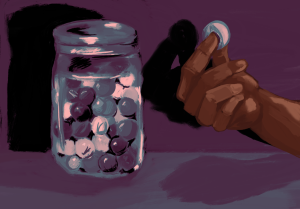The Killing
On Jan. 25, Alabama executed Kenneth Eugene Smith using pure nitrogen gas, marking the first time the method had ever been used worldwide. He was 58 years old, hired by debt-ridden preacher, Charles Senett, in 1988 to kill his wife Elizabeth for insurance money. Mr. Sennett killed himself as police closed in, and Smith’s fellow hitmen, John Forrest Parker and Billy Gray Williams, were executed and died in prison, respectively. Smith, however, ended up on death row for decades, even surviving a botched lethal injection in 2022.
Smith’s crime was somewhat interesting, but even more so was his punishment. As mentioned earlier, Smith was the first person ever executed using nitrogen gas, and for good reason – it’s a method wholly untested, disputed by doctors, and medical ethicists, and instead backed by criminologists and disconnected lawmakers. In Smith’s case, attorneys argued that he would be unconscious within seconds of use, and dead within minutes. Doctors, however, said that they could not specify, adding that oxygen deprivation – the crux of nitrogen gas execution – could lead to seizures.
They were right: Smith did not immediately lose consciousness. Instead, according to media witnesses, Smith thrashed on the gurney for at least two minutes, taking desperate, deep breaths. About 10 minutes later, his breathing was no longer visible. And about 17 minutes later, he was pronounced dead.
So, with doctors and attorneys neglected and ignored, why was this execution method used?
The Research
Enter Alabama Senate Bill 272, first sponsored by Sen. Trip Pittman (R) in 2018. In short, the bill allows nitrogen hypoxia to be used in execution if lethal injection is unavailable. Pittman cited a shortage of the drugs used for lethal injections as motivation for the bill, drawing inspiration from a similar 2015 bill in Oklahoma by Former Rep. Mike Christian (R).
To gain support for the bill, Christian said that several studies have been conducted on nitrogen hypoxia. One study that he requested from Oklahoma “doctors” stated that it would be painless and significantly cheaper than injections.
The study, “Nitrogen Induced Hypoxia as a Form of Capital Punishment,” was written by Michael Copeland, J.D.; Thom Parr, M.S.; and Christine Papas, J.D, P.H.D. While their post-name letters imply otherwise, it’s important to note that none of these authors actually have any medical certifications and are thus not doctors. Copeland is a licensed Civil Litigation attorney in Tulsa, Okla.; Parr is an assistant professor of human resources in the criminal justice program at East Central University in Ada, Okla.; and Pappas is a professor of political science and legal studies also at ECU.
The research itself is sparse, to say the least. It references and presents some older research studies, none that directly reference using nitrogen-induced hypoxia, though one does mention using nitrogen-induced unconsciousness. Between illogical conclusions and even a typo, it’s short of the real, rigorous research that legislators should be relying on when making life-changing legislation.
For example, the authors claim that nitrogen hypoxia is a reasonable method of execution because “Observed suicides involving inert gas hypoxia are described as peaceful.” To “prove” this, the authors cite a 2011 study regarding the nature of self-inflicted death via helium, not nitrogen.
The study also includes some basic errors that point to it not being peer-reviewed. For example, a mistake – or rather several – in the citations of the paper:

This is an error that is found easily through spellcheck, which makes the entire paper feel even more informal.
Additionally, the paper makes the claim, “Because nitrogen has not previously been used for capital punishment, there is a lack of scientific literature that specifically addresses its performance for that purpose; however, there have been medical experiments which involved subjects breathing pure nitrogen until they became unconscious.”
Now this is true; because human experimentation is typically looked down upon, nitrogen has been mainly tested as euthanasia for rats, which are a very common scientific model because of their genetic and physiological similarities to humans. The research article, “Nitrogen gas produces less behavioral and neurophysiological excitation than carbon dioxide in mice undergoing euthanasia,” is about finding a viable alternative to the commonly used carbon dioxide euthanasia agent used on rats. The writers found that, while the use of nitrogen reduced the behavioral activity and increased central neurological depression showing that it was less averse to the carbon dioxide agent, it still incited a fear response from the rats. This points to the idea that the gas is not completely painless, and the article mentions that more research would have to be done in order to say that this form of euthanasia is completely suitable.
This begs the question, was Smith’s execution human experimentation? Furthermore, should executions continue at all?
The Future
The death penalty has stood the test of time. From the first recorded death penalty laws in the 18th century B.C. to, over 3,000 years later, Pittman’s Senate Bill 272, capital punishment persists. Yet, development has happened; frankly, it’s ignorant to say that it hasn’t. Humans have gone from crucifixions and hanging, to lethal injection and electrocution. But in a day and age where we as humans are increasingly connected, capitalistic, and even cynical, maybe it’s time to lay the death penalty to rest.
For one, a common argument presented on behalf of the death penalty is that it serves as a deterrent to future criminals. However, this is easily established as false by any of a multitude of studies. A report written by the National Research Council of the National Academies, “Deterrence and the Death Penalty,” even highlighted the flaws that previous studies had – anything from only studying a single geographical unit to the use of “strong and unverifiable assumptions.” Thus, the fact of the matter is simple: the death penalty deters crime no more than a life sentence.
Another common myth is that executions are painless. In 2023, 24 people were executed, all by lethal injection. There are three different drugs used during a lethal injection, the flaws of which all work together to cause immense pain. (Usually) first comes sodium thiopental. Thiopental is supposed to act as a sedative/painkiller/anesthetic, but it may wear off before the end of the process. Thiopental is also suspected to cause pulmonary edema, also known as “wet lung.” This is shown through a forensic study that found foam in the lungs of people killed through this method, which could form if the individual was breathing as their lungs filled with fluid – a far from painless death.
Second is a neuromuscular blocking drug that stops muscle movement, or in other words, induces paralysis. This means that if the painkiller does wear off, any pain felt is silent, still, and speechless. It also may cause asphyxiation due to muscle paralysis.
Third and finally, a lethal dose of potassium chloride stops the heart, or at least tries to. It also has been shown to not reliably induce cardiac arrest, meaning an individual may die from suffocation rather than a painless heart attack.
It isn’t just those issues, though. The criminal justice system is far from perfect, and it’s not unheard of for an innocent person to be put behind bars. Losing your best years in prison is tragic in itself, but losing your life to a wrongful conviction is another level – a sentence irrevocable, irreversible, and punctuated all too soon.
Since 1973, at least 197 people originally put on death row have been exonerated. Admittedly, though, the number of people exonerated per year isn’t incredibly high, with only two people being released in 2023. Twenty years earlier, 2003, saw the highest number of exonerations in a year at 12.
Notably, more than half of the people who were exonerated were Black: 107 out of the 197 individuals. The U.S. justice system is clearly biased against marginalized individuals, which may lead to a person receiving a harsher sentence for the same crime. As a matter of fact, a study conducted in Philadelphia found that a convicted individual was 38% more likely to receive the death penalty if they were Black. The race of a murder victim also plays a significant role in whether or not a defendant receives the death penalty. In murder cases resulting in capital punishment, more than 75% of victims were White, despite White people only making up 50% of all murder victims in the U.S.
With the death penalty shown to be ineffective and anything but impartial, we must now look at the alternative: extended incarceration. At first thought, it might seem like keeping someone imprisoned for a long period of time would cost more than simply executing them. However, this is contrary to reality. A 2016 financial analysis from Susquehanna University found that each individual facing capital punishment costs $1.12 million more than other non-capital prisoners. This is mainly due to capital trials consuming more resources than regular ones. The process for jury selection is more complicated, attorneys spend more time preparing/presenting cases, and expert witnesses are almost always necessary.
In the end, the death penalty does not serve as the deterrent that its supporters claim it is. It’s not a punishment reserved for the worst of criminals. It’s a lottery, determined by race, sex, and economic status rather than just the severity of the crime. Executions are not painless and are easily botched. The truth is that the number of people dying by execution is getting lower every day – and Virginia even abolished the practice in 2021 – but Alabama performing an untested execution method on Smith shows that the country is still far from removing the death penalty completely.
The death penalty doesn’t deter crime, it doesn’t save money, and it doesn’t “fix” anything. It’s time for it to die.





















![Held up by a group of cheerleaders, flyer sophomore Leyu Yonas poses as part of a stunt, also supported by flyer junior Shayne Mitchell behind her. (Left) Prior to the pink out football game on Oct. 13, the athletes practiced in the aux gym from 5 p.m. to 6:30 p.m. (Right) On Oct. 19, the cheerleaders competed in their District Championships at Woodgrove High School. “We definitely put all our effort on the mat [at Districts], and it showed,” Mitchell said. Left: Photo by Nadia Shirr. Right: Photo by Steve Prakope via Victor O’Neill Studios.](https://theblazerrhs.com/wp-content/uploads/2023/11/feature-image-1200x823.png)
![Sophomore Xavier Smith (6), the Phoenix quarterback, runs the ball as his teammates help hold up the defense. “My [offensive] line collapses, so I just [have to run], and its a good way to get first downs because [Tuscarora’s] defense was really good,” Smith said.](https://theblazerrhs.com/wp-content/uploads/2023/11/IMG_5383-1200x897.jpg)



![As the referee throws the ball up for the tip-off, freshman Simone Diby leaps towards the ball to get it in Phoenix possession. Diby is a new member of the Phoenix girls basketball team, and despite it being a change, she finds it enjoyable. “It’s definitely a different experience if you’ve never played on a team, [but] I think it’s still fun.”](https://theblazerrhs.com/wp-content/uploads/2024/03/DSC_0057-1200x662.jpg)


![With the energy and effort the Bolts were bringing to the game, the Phoenix had to step up and match them to make it through their first game of the season. Many of the girls on the team, including freshman Nazly Rostom, have been playing soccer since their childhood and have grown a love for the sport as a result. “It was fun to see how we actually played in a [real] game,” Rostom said. “Even though the outcome was not what we were hoping for, I’m still happy we got to play together.”](https://theblazerrhs.com/wp-content/uploads/2024/04/DSC_0154-1200x800.jpg)
























